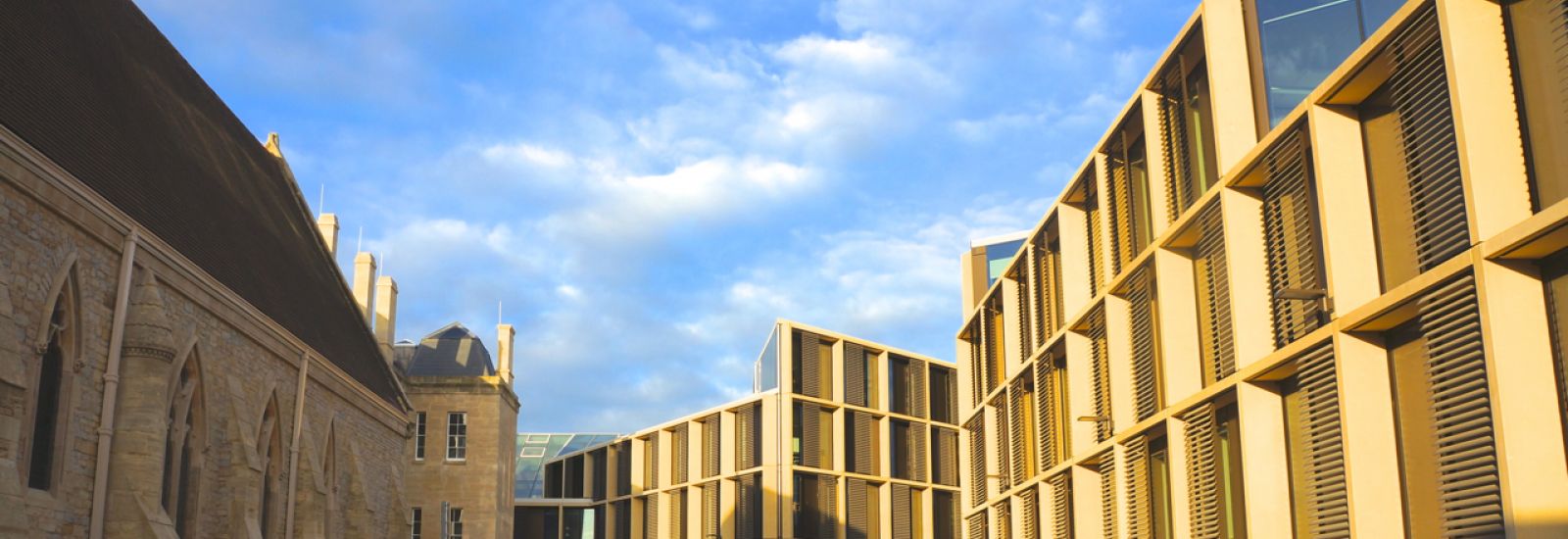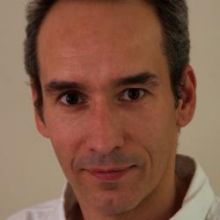
Professor Alain Goriely
'Mathematical modelling is one of the branches of applied mathematics which takes a question from any of the social, life, medical or physical sciences and transforms it into a mathematical statement that can then be analysed through mathematical methods.'
Professor Alain Goriely is speaking. Alain is Director of the Oxford Centre for Collaborative Applied Mathematics (OCCAM) and Professor of Mathematical Modelling. He works in the new Mathematical Institute building, in the heart of the Radcliffe Observatory Quarter.
'We aim to provide a rational analysis and gain insight into the mechanisms that are connected to a problem which in turn enables us to make predictions.' He continues, 'For example, in one of our current projects (with Henry Snaith) we look at a new generation of Photovoltaics devices. With the help of mathematical modelling, we were able to look at the problem of design optimisation of these cells. Together with our collaborators, this analysis suggested the possibility of designing windows of a given colour that can also integrate photovoltaic cells and produce electricity. We also built other models to understand the basic physical mechanisms, so providing a tool and a means of accelerating the physics research and providing new insights, cumulatively enhancing the research capability of the group.
'We are also working closely with doctors and biologists to understand the fundamental aspects of brain development, such as the fascinating gyrification patterns observed at the surface of the brain. This also has clinical implications: we’re looking at the modelling of swelling and damage that follows from a traumatic brain injury. When we realised these problems required a multi-disciplinary approach, we created an international network, the International Brain Mechanics and Trauma Lab. This network, based in Oxford, gathers the expertise of scientists around the world to address fundamental issues related to brain mechanics.'
How has the field of maths modelling changed over time, from when you started your career?
'What is clear is that every field of science has become increasingly quantitative. We are now in the process, across the board – in medicine, biology, engineering – of producing vast amounts of data, and it’s only through maths that you can make sense of this data. Only through modelling can you isolate and make sense of the basic mechanism and apply that to a predictive power.
'But the fundamentals remain the same: essentially maths provides a universal language to understand natural, human and societal phenomena. In all the fields we work in, whether the economy, the climate or the human body, there is a lot of work in understanding the intrinsic uncertainties that arise in these theories and limit our predictive power. In this instance, the role of the mathematician isn’t to try to provide a perfect prediction, but instead to find relevant and useful questions that can be tackled. So if you talk about the weather you're not going to try and predict the temperature at all times and all places, but the general trend of temperature evolution. Maths tells you what can be answered despite inherent complexity.'
What makes a good project?
'A good project has to be exciting and ambitious in an intellectual sense. It needs to address a question that you find important and interesting. You can be used as a technician to make a little model to help other people. Sometimes we do that because the question is interesting, even if the maths isn’t that deep. Problems, or classes of problem, that you think would present a clear intellectual challenge are welcome – another brick in building a general theory. But you can’t do any of this in a vacuum – it has to be meaningful within its field and done in close collaboration with experts from that discipline.
'It’s probably true for most of the problems that you can't get to the bottom of it – there’s a fine balance between a problem that everyone agrees is interesting and a problem you can actually contribute to. You have to identify the underlying complexity and change the question to one you can provide an answer for. So it's really important always to know what the most general fundamental problem is which sits behind smaller classes of problem.
'I particularly like problems that are to do with shape, biological functions, morphogenesis or which are intrinsically visually beautiful. For instance, with my colleague Derek Moulton, we have been working on models for the growth of sea shells. The question is to understand how these shapes and morphological patterns appear and develop during the development of an organism. I find that really appealing from an intellectual and aesthetic point of view – that by itself is a reason why it deserves an answer even if it has no clear application.'
How did you come to work here?
'I trained in Belgium in mathematical physics, and moved to the US working in the general area of applied mathematics for 17 years. I came to the UK about five years ago when the opportunity arose to join Oxford and take the directorship of the Oxford Centre for Collaborative Applied Mathematics.'
What are the mathematical modelling facilities and resources like at Oxford?
'The new Andrew Wiles building contains wonderful facilities for interaction. Many people, of any science or any discipline, just enjoy visiting. The space promotes open collaboration between disciplines. For instance, we recently had a debate between humanities and mathematics about narrative and proof - it’s very easy to do that around here. Other initiatives such as the Oxford Martin School also provides that kind of interdisciplinary application.
'Within maths we try to demonstrate the practical applications of our work, we try to be flexible and open to new ideas – the building provides an easy environment for that. Oxford in general is a wonderful place for applied mathematics, because of the interactions at all different levels between the different colleges and departments. Maths is highly regarded here as something that can enhance understanding of other disciplines.'
What type of character do you think make a good mathematician?
'In applied mathematics you have to be curious, you have to be ready to learn, and you should be ready to get out of your comfort zone. The key in interacting with other disciplines is the ability to ask questions and formulate problems that can be tackled mathematically, providing new insight in the process.'
What gives you most job satisfaction?
'I would say the joy of doing research and interacting with students and colleagues. But, above all, the most rewarding times are when you have a flash of understanding of certain natural phenomena through mathematics and a deeper understanding of mathematical structures through their realisation in sciences or art.'
What would you like to think of as the overall legacy of your work?
'Some people believe in the importance of their research and hope to have an intellectual legacy in terms of their work. Personally, my hope for a legacy is through the people I have interacted with: the students and colleagues. I hope that they will remember fondly our discussion and that it helped shape their vision of the world. As for myself, I hope to spend my last hour doing mathematics.'
